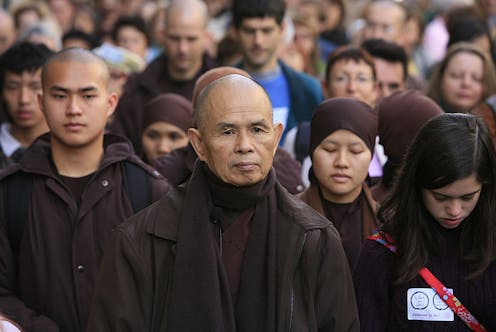What is walking meditation?
- Written by Brooke Schedneck, Assistant Professor of Religious Studies, Rhodes College

For Thich Nhat Hanh[1], the late Vietnamese monk who popularized mindfulness in the West, walking was not simply a way to get from one place to another, or an activity to be reserved for a perfect forest path[2]. It could be a profound contemplative practice putting people in touch with their breath, their bodies, the Earth – and an awareness of what he called “interbeing.”
Thich Nhat Hanh, who was one of the most influential Buddhist leaders in the world when he died Jan. 22[3], created the term[4] to describe “our deep interconnection with everything else.” “Everything relies on everything else in the cosmos in order to manifest – whether a star, a cloud, a flower, a tree, or you and me,” he explained[5].
As a scholar of contemporary Buddhism[6], I have studied how the monk’s teachings combine personal practices like mindfulness with social change – a movement called “engaged Buddhism,”[7] which Thich Nhat Hanh developed through his peaceful activism against the Vietnam War[8]. But one of his best-loved teachings is walking meditation, a key part of every visit to the 11 Plum Village monasteries[9] he founded around the world.
Thich Nhat Hanh believed that the Earth is sacred, so wherever someone walks, they can be reminded of this spiritual connection while also uniting their mind with their body[10]. He taught that people’s true homes are located in the present moment, through awareness of their steps on the Earth, their bodies, and their minds. Walking meditation brings practitioners back to this solid grounding.
Here are the steps of walking meditation as it is done in the Plum Village tradition:
1) Take a moment to breathe and center your body in the space you are about to walk. At Plum Village practice centers, monks and nuns lead participants in singing a few mindfulness songs[11] before starting. In “We’re All Moving[12],” for example, the group sings, “We’re all moving on a journey to nowhere, taking it easy, taking it slow. No more worries, no need to hurry, nothing to carry, let it all go.”
2) While walking, be mindful of your breath and your footsteps. Walk in a slow, relaxed way, preferably with a light smile. Think about the miracle of being alive and being able to step on Mother Earth, repeating these phrases[13]: “Breathing in, I know Mother Earth is in me. Breathing out, I know I am in Mother Earth.”
[Over 140,000 readers rely on The Conversation’s newsletters to understand the world. Sign up today[14].]
3) Take one breath per step, focusing on your foot touching the Earth. You can also notice how many steps you take while breathing in and then breathing out, naturally. The point is to find a connection between your breathing and your steps.
Instead of sitting meditation, Thich Nhat Hanh’s practices emphasize adding mindfulness to daily life anytime, anywhere. By incorporating walking meditation into a daily or weekly schedule, every step can be part of a deeper practice of interbeing.
References
- ^ Thich Nhat Hanh (theconversation.com)
- ^ perfect forest path (www.google.com)
- ^ he died Jan. 22 (apnews.com)
- ^ the term (www.garrisoninstitute.org)
- ^ he explained (www.garrisoninstitute.org)
- ^ a scholar of contemporary Buddhism (www.rhodes.edu)
- ^ “engaged Buddhism,” (cdn.theconversation.com)
- ^ the Vietnam War (www.penguinrandomhouse.com)
- ^ Plum Village monasteries (plumvillage.org)
- ^ uniting their mind with their body (www.lionsroar.com)
- ^ mindfulness songs (thichnhathanhfoundation.org)
- ^ We’re All Moving (www.youtube.com)
- ^ these phrases (www.google.com)
- ^ Sign up today (memberservices.theconversation.com)
Authors: Brooke Schedneck, Assistant Professor of Religious Studies, Rhodes College
Read more https://theconversation.com/what-is-walking-meditation-175989

